 About Authors:
About Authors:
Saravana Kumar K, Ramesh Y*,
Department of Pharmaceutics,
Seshachala College of Pharmacy,
Tirupathi – Chennai High way,
Puttur-517 583, Chittoor (dist),
A.P., India
Abstract
Plants and their extracts have immense potential for the management and treatment of wounds. Wound healing is complicated process that involves four phases: (i) coagulation begins immediately after injury, (ii) Inflammation which begins within hours, (iii) Proliferation which begins within days, (iv) Remodeling up to period of week, months, up to year. The phyto medicine for wound healing are not only cheap and affordable but are also purportedly safe as hypersensitive reactions are rarely encountered with the use of these agents. Mainly these crude drugs are obtained from various climatic conditions Collection, cultivating, Harvesting & Isolation of active ingredients to treat various types of diseases.
[adsense:336x280:8701650588]
Reference Id: PHARMATUTOR-ART-1225
Introduction
A wound is a disruption of tissue integrity that causes in damage and is typically associated with loss of function. Wound healing is defined as a complex phenomenon involving a number of processes, including induction of an acute-inflammatory process, regeneration of parenchyma inflammatory process, migration and proliferation of both parenchyma and connective tissue cells [1], synthesis of extra cellular Matrix (ECM) proteins, remodeling of connective tissue and parenchyma components (Purat Chikodya). Three different phase constitute the physiologic process of wound-healing, (i) Substrate Phase, (ii) Proliferate Phase, (iii) Remodeling phase. All these steps are orchestrated in controlled manner by a variety of cytokines including growth factor some growth factors have been identified in self healing wounds. Like platelet derived growth factor (PDGF), transforming growth factor B (TFG-B), fibroblast growth factor (FGF) and epidermal growth factor (EGF), etc.
Wounds are generally classified as, wounds without tissue loss (ex. In surgery), and wounds with tissue loss, such as burn wounds[2].
Many Ayurvedic herbal plants have a very important role in the process of wound healing. Plants are more potent healers because they promote the repair mechanisms in the natural way. The healing process can be physically monitored by assessing the rate of contraction of the wound [3].
List of Crude drugs to treat would heal:-
1. Allium cepa Linn
The plant Allium cepa Linn. Belonging to family Liliaceae. It contains kampferol, b-sitosterol, ferulic acid, myritic acid, prostaglandins. These constituents used as abortifaciant, bulb extract shown to have ecobolic effect in rats. Allium cepa Linn. Are proved to shown the anti-diabetic, anti-oxidant, anti-hypertensive, anti-thromobotic, hypoglycemic, antihyperlipidemic [4].
2. Ocimum kilimandscharicum
Ocimum kilimandscharicum, belonging to family Laminaceae. It is an aromatic under shrub with pubescent quadrangular branchless. It is an indigenous medicine for a variety of ailments like cough, bronchitis, viral infections, anorexia, and also wounds[5]. It contains tannins, flavonoids, proteins and other important constituents. Flavonoids possess antioxidant and free radical scavenging effect, wound healing, antibacterial property.
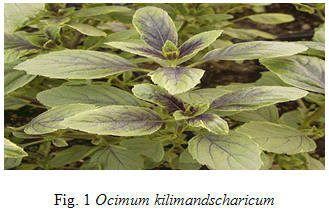
3. Kaemperia galanga
The rhizome of K. galangal is a indigenous medicine. It is used as expectorant, diuretic, carminative, and also has anticancer, antihypertensive, larvicidal activity, treatment of various skin disorders, rheumatism and diabetes mellitus. It mainly contains flavonoids [6]. K. galangal has shown to possess anti-oxidant property. The flavonoids mainly responsible for the force-radical scavenging activity and also wound healing activity.
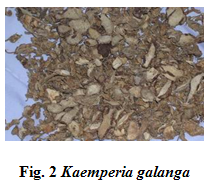
4. Raxid paeomiae root
It is the dried root of paeonia lactiflora pallas (paeonaceae) family. It is having anti-pyretic, heptoprotective, antifertility, antispasmodic, antifibrinolytic, and anti-inflammatory [7]. And also used for the healing of wounds, and also diuretic. The Raxid paeomiae root extract treated wound contraction. The Raxid paeomiae root extract was also promoting epithelialisation either by facilitating the proliferation of epithelial cells.
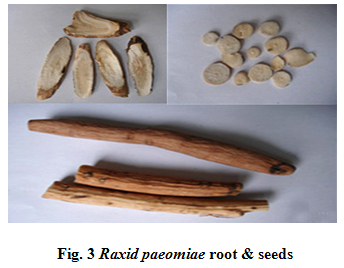
5. Lantana camara L.
It mainly contains saponins, fannins, triterpenes, alkaloids, flavonoids. It has several uses like antimicrobial, fungicidal, insecticidal, hematicidal activity and also immunosuppressive, antitumor activities; lantana oi is used for the treatment of skin itches, antiseptic for wounds. And externally for leprosy and scabies. And also Lantana extracts are used for the treatment of cancers, measles, children pox, asthma, ulcers, swelling, eczema, tumors, high blood pressure, bilious fevers, catarrhal infections, tetanus, rheumatism, malaria and ataxia of abdominal viscera [8].
6. Carica papaya Latex
Carica papaya (Caricaceae), papaya fruits contains a mixture of cysteine endopeptidases such as papain. Chympopapain A and B, papaya endopeptidase II, papaya endopeptidase IV, omega endopeptidase. Chinitase, protease-inhibitors, linanarse, proteins [9]. Papaya fruits posses wound healing properties, papaya latex was applied to the burn wound using hydrogel as a vehicle system.
7. Aloe Vera Leaf
It is one of the oldest healing plants known to mankind. It is used topically for cuts, burns, insects stings, bruises, acne and blemishes, poisoning, welts, skin lesions, eczema, sunburns. Aloe Vera plant to rub on the wounds of his soldiers and also traditionally use for stomach and intestinal disorders and also it has to enhance immune systems [10]. Aloe Vera leaf contains Vitamin C, Vitamin E and amino acids which are essential for wound healing.
8. Musa sapientum (Plantain banana)
Mua sapientum var. paradisiacal (Musaceae). It contains flavonoids (leucocyanidin) sterylacylglycosides and sitoindisides I-IV. Sitoindoside IV was reported to mobilize and activate peritoneal macrophages with increase in DNA and [3H] thymidine uptake [11]. Flavonoids are known to reduce lipid peroxidation flavonoids are also known to promote the wound healing process mainly due to their astringent and antimicrobial property, which results to be responsible for wound contraction and increased rate of epithelialisation.
9. Tragia plukenetii
Tragia plukenetii (Euphorbiaceae), it contains alkaloid an terpenes, the extract of Tragia plukenetii and the extract of Tragia plukenetii shows the antibacterial activity of the ethanol extract carried out on the plant under study revealed the inhibition of the growth of the S. aureus which is causative organism leading to septic condition [12]. And also the ethanol extract possess the wound healing, antiseptic, anti-inflammatory activity reported to controlling the inflammation during the wound occurrence.
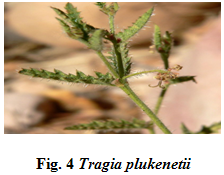
10. Desmodium gangeticum
It is used in Indian system of medicine as a bitter tonic, febrifuges digestive, anticatarrhal, antiemetic, inflammatory conditions of chest and various other inflammatory conditions due to tie ‘sata’ disorders. And also it possess antiwrithing activity, moderate central nervous system depressant activity and antileishmaninal activity and also anti-inflammatory, analgesic activities[13].
Alkaloidal context of this plant possess – anti-cholinesterase, smooth muscle stimulant, CNS-stimulant, depressant responses and also possess anti-oxidant activity.
Desmodium gangeticum contains alkaloids pterocarpnoid, flavonoid and isoflavanoid glycosides and terpenes etc.
NOW YOU CAN ALSO PUBLISH YOUR ARTICLE ONLINE.
SUBMIT YOUR ARTICLE/PROJECT AT articles@pharmatutor.org
Subscribe to Pharmatutor Alerts by Email
FIND OUT MORE ARTICLES AT OUR DATABASE
11. Rubus sanctus
Rubus species (Rosaceae), it is mainly used for the treatment of diabetes mellitus, rheumatism, sore throat, hemorrhoid, diarrhea Roots decoction of Rubus sanctus is used as herbal tea to elevate pain and to heral rheumatism.
Rubus species, having antimicrobial, anticonvulsant, muscle relaxant, anti-inflammatory, antinociceptive activities. It mainly contains phenolic carboxylic acids, like ellagic acid, phenyl propanoids, caffeic acid[14].
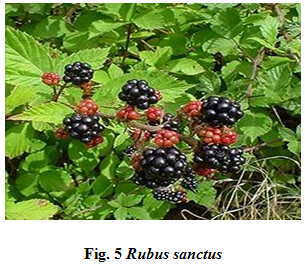
12. Tephrosia purpurea (Linn.)
Tephrosia purpurea (Linn.) pers (Leguninosae). It also called as “Sarwa Wranvishapaka”. It contains glycosides, rotenoids, isoflavones, flavnones, chalcones, flavonoids and sterols. According to Ayurvedic system of medicine various parts of this plant are used as remedy for impotency, asthma, diarrhoea, gonorrhoea, rheumatism, ulcer and urinary disorders. An also it cures diseases of kidney, liver, spleen, heart and blood [15].
The dried herb is tonic, laxative, diuretic and deobstruments. And also used in the treatment of bronchitis, boils, bleeding piles, pimples, roots and seeds are used as insecticidal, vermifuge, leprous wound. And the juice is used for the eruption on skin [16]. Decoction is used in vomiting. An extract of pods is effective for pain, inflammation (The Wealth of India, 1976).
13. Quercus infectoria
Quercus infectoria is a small tree (Fagaceae). It is mainly used for the treatment of anti-inflammatory disorders (The Wealth of India, 1995) and also used as dental powder, toothache treatment, gingivitis. Pharmacologically it acts as a astringent, antidiabetic, antiviral, antitremorine, local anaesthetic, antibacterial, antifungal, anti-inflammatory and larvicidal activities. It mainly contains tannin (50-70%) and small amounts of gallic acid ellagic acid [17].
14. Vinca rosea
Vinca roseai is also called as Catharanthus roseus L. belonging to family – Pocyanaceae. It is mainly contains alkaloids, tannins, triterpenoids. It is mainly used for the treatment of Hodgkin’s disease, malignant lymphomas, neuroblastoma, rhabolomysarcoma, win’s tumor and cancers and also use in European countries used in the conditions like headache, diabetes [18]. And also it is vasodilating and memory enhancing properties have been shown to alleviate vascular dementia and Alzheiner disease.
15. Sphaeranthus indicus Linn.
Sphaeranthus indicus Linn. Belongs to family Asteraceae. This plant also known as Gorakhmundi in Hindi. The plant is mainly used for the epileptic conditions (Convulsions), mental illness and hermicranias[19]. The external application of this paste is used for the treatment of prurtius and edema, arthritis, filariasis, gout and cervical adenopathy. It mainly contains essential oil, ocimene, a-tempinene, methyl-chavical, a-citrol, a-ionon, b-ionone, d-cadinene, r-methoxycin, unamaldehyde and alkaloid Sphaeranthine.
16. Hyptis suaveolens (L.) Poit
The plant, Hyptis suaveolens (L.) poit belongs to family Lamiaceae. The extract of Hyptis suaveolens contains steroids, alkaloids, carbohydrates, proteins, flavonoids, tannins, glycosides, leaves of this plant used as stimulant, carminative, sudorific, galactogogue, parasitic cutaneous disease[20], leaf extracts used as a relief to colic and stomachaches leaves and twigs are acts as antirheumatic and antisuporific bats, anti-inflammatory antifertility. Decoction is used for the appetizer and leaves of the plant also used to repel mosquitoes and control insect pests of stored grains. Tribalmen continue to use the plant in the treatment of wound.
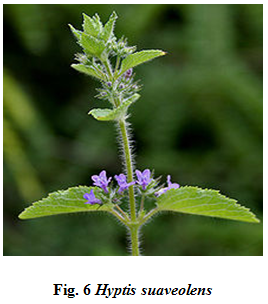
17. Tectona grandis leaves
Tectona grandis is commonly known as Indian teak, and belongs to family “verabinaceae”. It contains mainly carbohydrates, tannins and anthraquinone glycosides. Tectona grandis is used as anti-inflammatory agents and also used topically for the treatment of burns[21].
It is mainly used for the injuries like burn, inflicted wound and skin ulcers. The extract applied topically (or) given orally promoted the breaking strength, wound contraction and collegenation.
18. Morinda citrifolia Linn.
Morinda citrifolia is also known as Indian mulberry, belongs to family; Rubiaceae. It mainly contains saponnins, tannins, tri terpenes, alkaloids, flavonoids. It is mainly used for the bowel disorders, including arthritis, atherosclerosis, bladder infections, boils, burns, cancer, chronic fatigue syndrome, circulatory weakness, cold, congestion, constipation, diabetes, eye inflammations, fever, fractures, gastric ulcers, gingivitis [22], headaches, heart diseases, hypertension, immune weakness, indigestion, intestinal parasites, kidney disease, malaria, menstrual cramps, mouth sores, respiratory disorders, ringworms, sinusitis, sprains, stroke, skin inflammation and wounds.
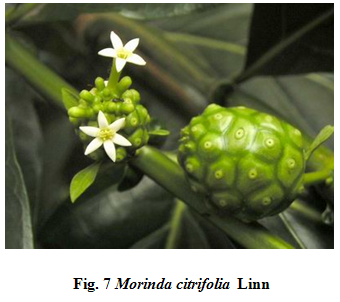
19. Ageratum conyzoides Linn. (Poly herbal formulation)
Ageratum conyzoides belonging to Asteraceae. The leaves are applied to the wounds act as septic and well them quickly. The fresh juice of the plant and extract of dried plant are used to cure allergic rhinitis and sinusitis [23].
CONCLUSION
Finally I concluded that the advent of allopathic system of medicine which is based on the fast-therapeutic actions of synthetic drugs as in the case of wound healing, herbal medicine has gained the momentum and it is evident from the fact that certain herbal remedies are mentioned in this review. The present review clearly revealed that wound healing are now reported scientifically. These natural agencies were better target for the development of alternatives to synthetic drugs.
REFERENCES
1. Akcos Y, Ye ilada E, Ezer N. Anti-inflammatory activity of some Turkish Rubus species. Hacettepe Univ J Fac Pharm. 1998; 18: 33-8.
2. Anonymous, The Wealth of India: A Dictionary of Indian Raw Materials and Industrial Products, 13 volume series. Publications & Information Directorate (CSIR), New Delhi. 1995; 351.
3. Aukhil I., Periodontol, Biology of wound healing. 2000; 22: 300-302.
4. Avasthi B.K, Tewari JD, A preliminary phytochemical investigation of Desmodium gangeticum DC. (Leguminosae). J. Am. Pharm. Assoc. Am. Pharm. Assoc. (Baltim). 1955; 44: 625-627.
5. Azarkan M, EI Moussaoui A, Van Wuytswinkel D, Dehon G, Looze Y. Fractionation and purification of the enzymes stored in the latex of Carica papaya. Journal of Chromatography B. 790: 2003: 229-238.
6. Azarkan M, Wintjens R, Looze Y, Baeyens-Volant D, Detection o three wound-induced proteins in papaya latex. Phytochemistry. 65: 2004; 225-234.
7. Basu NK, PP, Lasmal. Chemical investigation of Sphaeranthus indicus Linn, Journal of American Pharmaceutical Association. 35: 1946; 274-275.
8. Chatterjee A, Pakrashi SC; The Treatise on Indian Medicinal Plants, Vol. 5, PID, New Delhi. 1997; 15.
9. Chatterjee TK Medicinal plant with antifertility property. Herbal Option 1997; 77.
10. Chopra RN, Nayar SI, Chopra IC; Glossary of Indian Medicinal Plant. Council of Scientific and Industrial Research, India. 1956; 208.
11. Compos KE, Diniz YS, Cataneo AC, Faine LA, Alves MJ, Nobeli EL; Hypoglycemic and antioxidant effect of onion, Allium cepa: diatary onion addition, antioxidant activity and hypoglycic effect on diabetic rats. Int J Food Sci Nutr. 2003; 54: 241-6.
12. Dar MS, Ikram M. Studies on Quercus infectoria; isolation of syringic acid and determination of its central depressive activity. Planta Med. 1979; 35: 156–161.
13. Davis R. Inhibitory and stimulatory systems in Aloe vera. Aloe Today Winter. 1992.
14. Davis R.H, Kabbani JM, Maro NP. Aloe vera and wound healing. J. Am. Podiatr. Med. Assoc. 77: 1987; 165-169.
15. Day MD, Wiley CJ, Playford J, Zalucki MP. Lantana : Current Management, Status and Future Prospects. Australian Centre for International Agricultural Research : Canberra. 2003.
16. Despande S.S, Shah G.B, Parmar N.S. Antiulcer activity of Tephrosia purpurea in rats. Indian Journal of Pharmacology 35: 2000; 168-172.
17. Dhanprakash BN, Garima U. Antioxidant and free radical scavenging activities of phenols from onion (Allium cepa). Food Chemistry. 2007; 102: 1389-1393
18. Digraki M, Alma MH, Ilcim A, Sen S. Antibacterial and antifungal effects of various commercial plant extracts. Pharm Biol. 1999; 37:216-20.
19. Dispasquale G, Meli A. Effect of body weight changes on the formation of cotton pellet induced granuloma, J Pharm Pharmacol. 1965; 17 : 79-82.
20. Elkins R. Hawaiian Noni (Morinda citrifolia) Pleasant Grove, UT: Woodland Publishing. 1997.
21. Fatima S, Farooqi AHA, Kumar R, Kumar TRS, Khanuja SPS. Antibacterial activity possessed by medicinal plants used in tooth powders. J Med Aromatic Plant Sci. 2001; 22:187-9.
22. Fischhof P.K.R. Moslinger-Gehmayr W.M. Herrmann A. Friedmann D.L. Russmann. Theraupetic efficacy of Vincamine in dementia. Neuropsychobiology, 34: 1996; 29-35.
23. Galal EE, Gawad MA Antidiabetic activity of Egyptian onion Allium cepa extract; J Egypt Med Assoc 1965; 48: 14-45.
NOW YOU CAN ALSO PUBLISH YOUR ARTICLE ONLINE.
SUBMIT YOUR ARTICLE/PROJECT AT articles@pharmatutor.org
Subscribe to Pharmatutor Alerts by Email
FIND OUT MORE ARTICLES AT OUR DATABASE









